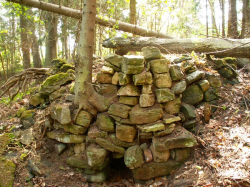Tar furnaces of Valgi 



Tar furnaces of Valgi. The skill of burning tar reached our area probably via Baltic tribes apparently already in the old times. The word “tar” is also probably borrowed from the Baltic’s (in Latvian darva, in Lithuanian derva). Tar was needed for tarring the ships, boats, carts and many others. Pine stumps with pitch-rich roots were used as raw material in tarring. The best were stumps, which had been in the ground for years. After drying, they were chopped with an axe. The tar furnace used in Estonia was rather small, built partially into the ground with a shape of a double cylinder. The inner cylinder (mother furnace) was filled with roots, the outer (father furnace) was a fireplace. In order for the furnace to ventilate and for the smoke to exit, there were vent-holes or a chimney in the upper part of the furnace. The bottom of the inner furnace was composed of a limestone board or stamped hard clay. The floor had to incline toward the outflow hole, where there was a drain or a pipe, which ended with a container for collecting tar. About hundred mugs of tar were produced by daily heating. This kind of a tar furnace was still used in the beginning of the 20th century on islands and Southeast Estonia. Direct copies to that can be found in Gotland.
The furnaces were built to places where raw material was at hand. On Ruhnu tar was produced in the area of Överkirke as well as in Valgi in the neighbourhood of barracks. The remains of three furnaces can be well observed there. A stone storage has preserved from one of the furnaces, the second one is located about 15 metres to the southeast of the middle one, the place of the furnace is marked by a 5-metre diameter wall. The third furnace is located 30 metres to the northwest of the middle one.
Further reading
- I. Talve. Tõrva- ja miilipõletamine Eestis. 1940. Käsikiri (in Estonian)
- I. Talve. Kaakkois-Viron ja Liivin rannikon tervanpoltosta. – Virittäjä, 1961, 73– 79 (in Finnish)
- A. Viires. Kotiteollisuus ja ansiotyöt Viron saaristoväen elämässä. – Kotiseutu, 1967, 174–175 (in Finnish)
- M. Leetmaa. Lubja- ja tõrvaahjud. – Suitsutare 2. Tallinn, 2000 (in Estonian)
- A. Viires. Kultuur ja traditsioon. Tartu, 2001, 150–152 (in Estonian)
- Hiiumaa pärandkultuurist. Saaremaa pärandkultuurist. Kärdla - Kuressaare, 2011 (in Estonian)
Created in 2013






